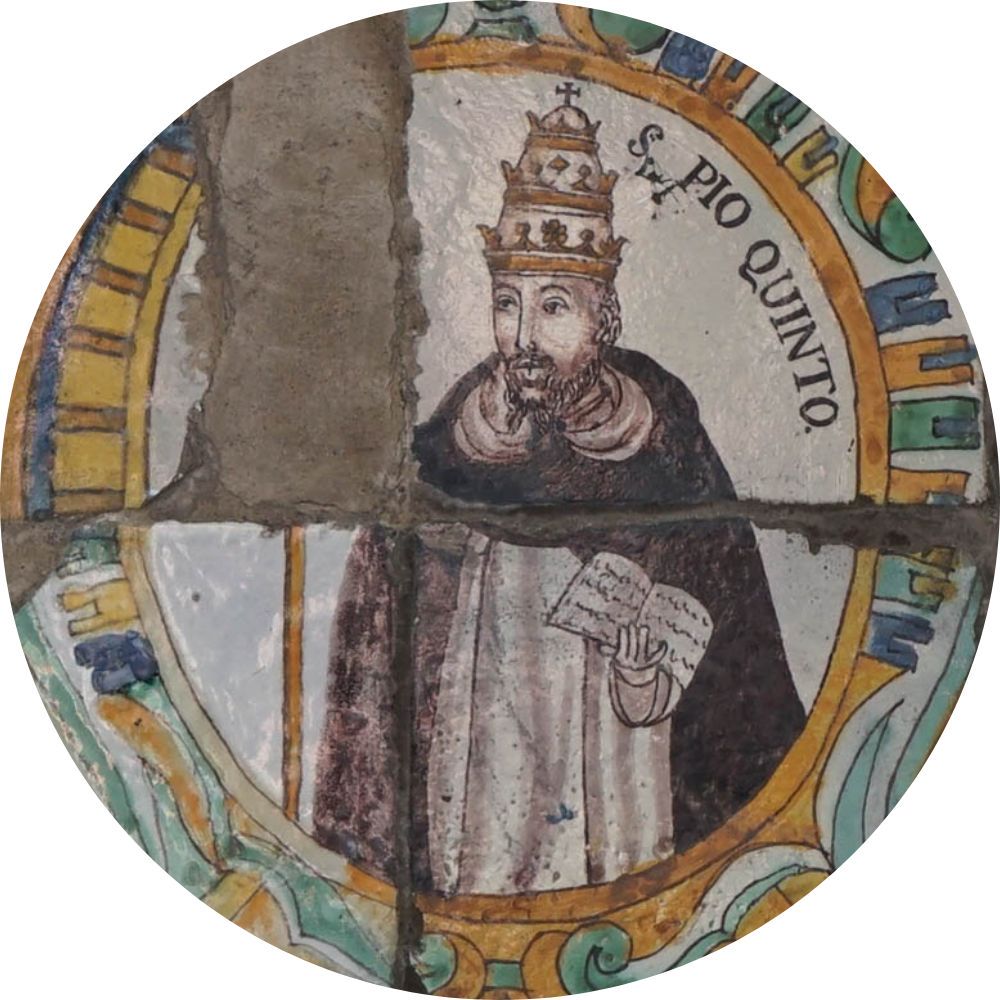St. Pius V
St. Pius V, pope
(1504-1572)
Antonio Michiele Ghislieri was born on January 17, 1504, in Bosco Marengo to a poor Ghislieri family. When he was young, he worked as a shepherd. In 1518, at the age of 14, he entered the Order of Preachers in Vigevano, where he took the name Michele. After ten years, he was ordained a priest. For several years he was vicar of the Inquisition tribunals - first in Bergamo, then in Pavia, where he stayed for as long as 16 years. From 1550, he was inquisitor of the Diocese of Como, where he waged a dispute with the cathedral chapter, suspected of favoring the Reformation. Thanks to his unyielding attitude and strong commitment, he became a delegate of the Roman Inquisition. On June 3, 1551, Pope Julius III appointed him general commissioner of the Roman Inquisition. With the bull of August 20, 1553, the same pope conferred on him the title of magister, which was not a confirmation of his skills acquired during his studies but occurred by virtue of apostolic authority.
At the will of Pope Paul IV, he became a bishop in September 1556 and a cardinal in March 1557. After the death of Pius IV, Antonio Michele Ghislieri was elected pope on January 7, 1566 and took the name Pius V. He was crowned on his birthday. He decided to still live the life he was used to - in accordance with the monastic rule. This ascetic, monk and former inquisitor devoted his entire pontificate to reforming the Church and fighting heresy. He implemented the provisions of the Council of Trent. He forbade the children of clergy to inherit church property, ordered bishops residing in Rome to return to their dioceses, and commanded all monks staying outside monasteries - in violation of monastic rules - to come back to their congregations. Although he used harsh rules and approved the judgments of the Inquisition, he was regarded as a fair judge. In 1567, he announced St. Thomas Aquinas as the Doctor of the Church and ordered the publication of all his works. He also made efforts to have the liturgical books reissued and the Church's catechism published for the first time.
In 1570, Pope Pius V issued the bull Regnans in Excelsis, under which he excommunicated Queen Elizabeth I of England for heresy and persecution of Catholics in her country. He also orchestrated the formation of the anti-Turkish Holy League, an alliance of Catholic states against the Ottoman Empire. The victory of the armies of Christian countries against the Ottoman forces at the Battle of Lepanto in 1571 was attributed by the Pope to the intercession of the Blessed Virgin Mary. In commemoration of this victory, he established the feast of Our Lady of Victory.
He died on May 1, 1572 at the Vatican in the reputation of sainthood. He was originally buried in St. Peter's Basilica, but in January 1588 his remains were transferred to the Basilica of Saint Mary Major. On the centenary of his death, he was beatified by Clement X. Forty years later, Clement XI declared him a saint. His memorial according to the liturgical calendar falls on a day in April.
In iconography, St. Pius V is shown in various ways. Sometimes he is depicted in full papal attire, other times in a Dominican habit, but wearing a papal tiara on his head. This is how he is depicted in the image in question. However, there is a second depiction of him on the walls of this cloister, among four other cardinals descended from the Dominican order. On this plate he has a red cardinal's cape, but unlike the other cardinals, this one has a tiara on his head, indicating that we are dealing with the Pope. From 1310, it consisted of three crowns; this was introduced by Pope Clement V. It has its own symbolism: the upper crown represents the Glory of being chosen as a Servant of the Servants of God; the central crown represents the Power given by Christ to Peter to "bind and loose" on earth as well as in heaven; and the lower crown represents the authority over the Universal Church.
Other of his attributes that we can find in the iconography are also the Virgin Mary and the rosary, which refer to Marian devotion, which was important in the Pope's life. It is with him that the feast of Our Lady of Victory is associated, which was later renamed Our Lady of the Rosary. He can also be seen with a fiery sword - an attribute that reminds us of the determined battle he waged against deviants to the Catholic faith; it also alludes to his concern for the purity of faith and morals.
Bibliography:
- Catena G., Vita del gloriosissimo papa Pio quinto, Roma, 1587.
- Fouillit J.-B., La vie du tres -saint pape Pie V. beatifie’ par N. S. Pere le Pape Clement X. Le 1. May 1672, Paris 1672.
- Antony C. M, Saint Pius V Pope of the Holy Rosary, London 1911 (The Frair Saints Series).
- Silli A., San Pio. Note agiografiche ed iconografiche, Roma 1979.
- Martínez Angel C., San Pío V. Papa y defensor de la fe (1504-1571), [in:] Nueve personajes històricos. Domingo de Guzman, Jordan de Sajonia, Tomas de Aquino, Humberto de Romans, Catalina de Siena, Vincente Ferrer, Pío V, Martín de Porres, Rosa de Lima, Caleruega 1983 (Familia Dominicana, 1), pp. 173-188.

